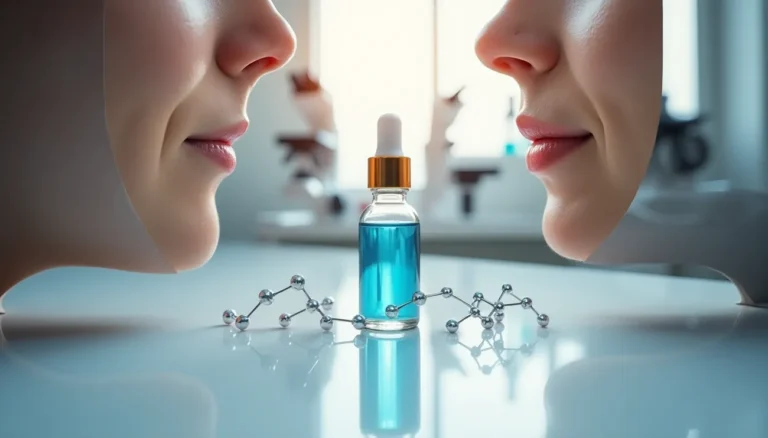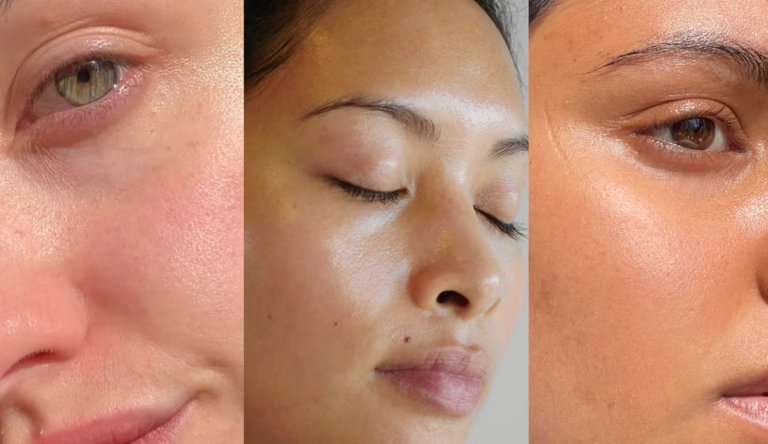How to Build Your Skincare Routine: Ultimate Dermatologist Recommended Tips
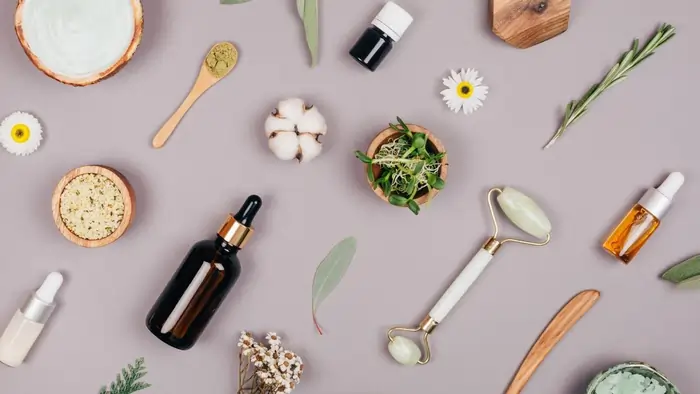
Wondering how to build your skincare routine in your 40s? You’re not alone—this decade often brings sudden and dramatic changes to your skin. According to dermatologists, these shifts are real and scientifically backed. Declining estrogen levels, years of sun exposure, and the stress of a busy lifestyle all converge, making it essential to rethink your approach to skincare.
The good news? You can build an effective, dermatologist-approved anti-aging skincare routine without spending a fortune—many powerful products cost less than $150 total. Studies show that ingredients like retinoids visibly reduce fine lines and wrinkles in as little as 12 weeks, while daily sunscreen use can slash your risk of skin cancer by 50%.
In this guide, we’ll show you how to build your skincare routine from the ground up—focusing on science-backed solutions tailored specifically for your 40s. From product recommendations to application tips, you’ll learn a proven system that delivers real results.
📺 **Watch Now: How to Build Your Skincare Routine: Ultimate Dermatologist Recommended Tips **
Understanding Skin Changes in Your 40s

Image Source: Freepik
Looking in the mirror tells no lies—especially when you hit your 40s. Your skin goes through major changes during this decade due to internal biological processes and years of environmental exposure.
How Hormonal Changes in Your 40s Affect Your Skin — and Why It Matters When Building Your Skincare Routine
As you enter your 40s, hormonal changes—particularly during perimenopause—can dramatically impact your skin. Estrogen, a hormone essential not just for reproduction but also for skin health, begins to decline. This drop affects fibroblasts (which produce collagen), keratinocytes (your skin’s protective cells), and melanocytes (which control pigmentation) [1].
The result? Your skin starts to thin—by about 1.13% per year—and collagen levels drop around 2% annually after menopause [2]. Oil production also slows, leading to dryness, dullness, and reduced elasticity [3].
At the same time, falling progesterone levels affect your skin’s structure, healing capacity, and resilience against inflammation [2]. Elevated cortisol, the stress hormone, further weakens your skin’s barrier and may trigger or worsen conditions like eczema, rosacea, and psoriasis [4].
Understanding these hormonal shifts is key when learning how to build your skincare routine in your 40s. A targeted, hormone-aware skincare approach helps you maintain skin health, minimize signs of aging, and strengthen your skin’s protective barrier.
Common Skin Concerns After 40
Several skin changes become obvious in your 40s:
- Dryness and texture changes: Lower hormone levels reduce oil production and your skin’s moisture retention through hyaluronic acid [3]
- Fine lines and wrinkles: Expression lines become deeper, especially around your eyes, between eyebrows, forehead, and mouth [5]
- Hyperpigmentation: Melanocyte cells decrease by about 10% each decade after 30, causing uneven pigmentation and age spots [5]
- Volume loss and sagging: Face volume loss becomes visible around age 45, particularly in the jawline area (jowls) [5]
Your skin becomes thinner with reduced elasticity, more wrinkles, and decreased blood flow [2]. Wounds take longer to heal, and skin becomes more delicate [6].
The Science of Collagen Loss — A Core Factor in Building Your Skincare Routine in Your 40s
Collagen loss is one of the most significant changes your skin faces in your 40s. This structural protein is responsible for skin firmness, elasticity, and smooth texture. Collagen production begins to decline in your mid-20s, and by your early 30s, you’re losing about 1% each year [7].
During the first five years of perimenopause, this process accelerates—skin collagen levels can drop by up to 30% [8]. After menopause, the decline continues at roughly 2.1% per year [8].
This loss is influenced by both internal and external factors. Genetically, your body produces less collagen types I and III due to aging fibroblasts and reduced cellular stimulation [8]. Externally, UV exposure is the main culprit behind premature aging—responsible for up to 90% of visible skin damage by degrading collagen and elastin fibers [3].
When collagen diminishes, your skin loses its bounce-back ability, leading to sagging, wrinkles, and fine lines—especially in high-movement areas like the eyes and mouth [6].
If you’re wondering how to build your skincare routine to combat these changes, understanding collagen biology is essential. A smart, dermatologist-backed routine will focus on stimulating collagen production and protecting the existing structure with targeted treatments, rather than relying on generic anti-aging solutions.
Resources:
- American Academy of Dermatology: Skin care in your 40s and 50s
- National Institute on Aging: Skin Care and Aging
Essential Ingredients for Your Anti-Aging Skin Care Routine
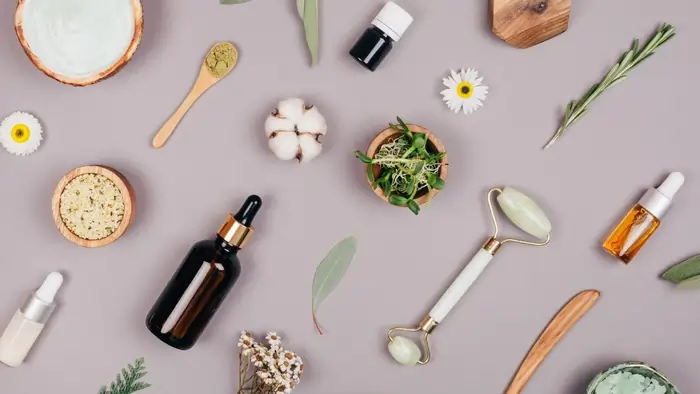
Image Source: Kim Gallo Esthetics
Your anti-aging routine becomes effective when you know which ingredients really work. Scientists have discovered several powerful components that target skin issues common in our 40s.
“In your 40s, the key skincare ingredients to prioritize are retinoids, vitamin C, peptides, and ceramides,” says Dr. Jennifer Smith, board-certified dermatologist with 15 years of experience. “Retinoids, in particular, are the gold standard for stimulating collagen production and accelerating cell turnover, which naturally decreases by about 1% per year after age 40.”
Retinoids: The Gold Standard Ingredient When Building Your Skincare Routine
When it comes to anti-aging skincare, dermatologists overwhelmingly agree: retinoids are essential. These vitamin A derivatives have been extensively studied since the 1970s [9] and are second only to sunscreen in terms of proven effectiveness for maintaining youthful skin.
Retinoids offer three major benefits: they accelerate cell turnover, boost collagen production, and regulate oil levels [10]. These effects work together to reduce fine lines, wrinkles, uneven skin tone, and even adult acne. Clinical studies confirm that consistent use of retinoids can visibly improve wrinkles in as little as 12 weeks, with optimal results appearing between 6 to 12 months [9].
If you’re researching how to build your skincare routine in your 40s, incorporating a retinoid is non-negotiable. It’s one of the few ingredients with decades of clinical data proving its long-term anti-aging benefits.
The retinoid family comes in different strengths:
- Retinol: Standard over-the-counter form
- Tretinoin (Retin-A): Prescription-strength version
- Adapalene: Now available over-the-counter
- Retinaldehyde: Stronger than retinol but gentler than prescription options
Beginners should use retinol twice weekly and slowly increase frequency as their skin adjusts [11]. Remember to apply retinoids at night because sunlight breaks them down and they can make your skin more sensitive to sun [12].
Vitamin C and Antioxidants: Essential Daytime Defense in Your Skincare Routine
If you’re learning how to build your skincare routine, especially in your 40s, vitamin C should be a core part of your morning regimen. While retinoids work overnight to renew your skin, vitamin C protects it during the day by neutralizing harmful free radicals that accelerate aging [13].
Topical serums with 15% vitamin C are clinically shown to brighten dull skin, fade hyperpigmentation, and guard against pollution and UV-related damage [14]. For best results, choose formulations that include ferulic acid, which stabilizes vitamin C and enhances its antioxidant power [15].
Vitamin C also reduces melanin production, helping to fade age spots and improve overall skin tone—common concerns as hormonal shifts in your 40s increase pigmentation [16].
Adding a high-quality vitamin C serum is a smart, dermatologist-approved step when deciding how to build your skincare routine to defend and repair skin daily.
Hyaluronic Acid and Peptides: Hydration Powerhouses for Your 40s Skincare Routine
As you age, your skin’s ability to retain moisture declines—making hydration a non-negotiable step when learning how to build your skincare routine in your 40s. Two of the most effective ingredients to restore and lock in moisture are hyaluronic acid and peptides.
Hyaluronic acid is a standout humectant that holds up to 1,000 times its weight in water [10]. This not only provides deep, lasting hydration but also plumps the skin, helping to smooth out fine lines and maintain a youthful texture.
Peptides, on the other hand, act as cellular messengers. They signal skin cells to boost production of collagen and elastin—two critical proteins that support firmness and elasticity [10]. Clinical studies show that topical peptides can significantly reduce wrinkles in as little as two weeks [15].
Even more impressively, peptides stimulate multiple types of collagen (I, III, IV, VII, and XVII) [17], making them a versatile anti-aging solution. When you’re deciding how to build your skincare routine, incorporating these two ingredients helps address both dehydration and structural skin decline—two core issues in your 40s.
Niacinamide and Other Key Ingredients to Enhance Your Skincare Routine
When learning how to build your skincare routine in your 40s, niacinamide (vitamin B3) should be a staple. This versatile ingredient addresses several common skin concerns: it controls oil, reduces redness, strengthens the skin’s protective barrier, and lightens dark spots [2].
Niacinamide pairs well with other powerful anti-aging ingredients. For example, it works in harmony with retinoids to reduce irritation [2] and enhances the brightening effects of vitamin C [5]. Research has shown that even a 4% concentration of niacinamide can visibly improve pore size, rough texture, and skin tone in just 8 weeks [2].
Another important addition to your routine is ceramides. These lipids help repair the skin’s barrier by filling in the “gaps” between cells [10], improving overall elasticity and resilience.
Incorporating both niacinamide and ceramides into your skincare routine for your 40s helps boost your skin’s hydration, texture, and protection from environmental stressors.
Resources:
- American Academy of Dermatology: Retinoid Guidance
- National Institutes of Health: Research on Topical Vitamin C
- Harvard Health Publishing: Anti-Aging Skincare Science
Building Your Morning Skin Care Routine
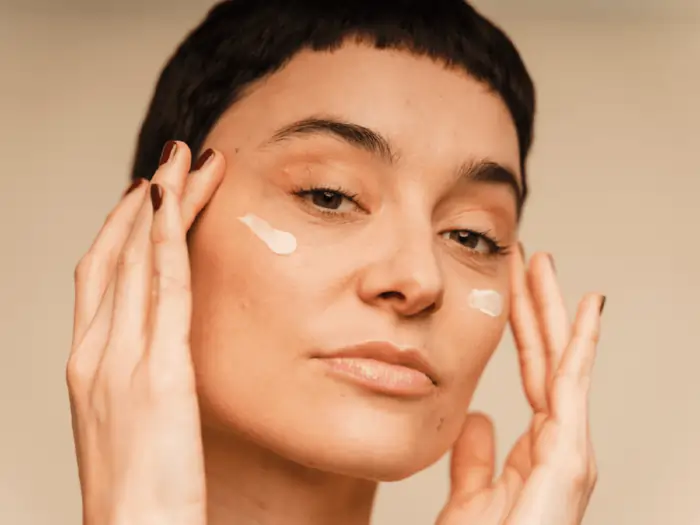
Image Source: Byrdie
A good morning skincare routine will protect your skin throughout the day. Your skin needs more attention and care in your 40s, so you should choose products and application methods carefully.
Gentle Cleansing Techniques
Mature skin needs balanced cleansing that removes overnight buildup while preserving natural oils that keep your skin soft and plump [6]. You should pick hydrating, sulfate-free cleansers instead of harsh foaming products that can damage your skin barrier.
Your skin makes less sebum in your 40s, which leaves it exposed to environmental damage [6]. Here’s what works best for morning cleansing:
- Use lukewarm water instead of hot water that strips moisture [3]
- Apply gentle pressure with a 60-second facial massage to boost blood flow [3]
- Pick oil-based or cream cleansers that clean while keeping skin hydrated [6]
Some skin experts say you might only need water or a damp cloth in the morning if your skin feels dry. You can save your deep cleanse for nighttime [3].
Serums and Treatment Products: Essential for an Effective Skincare Routine
When deciding how to build your skincare routine, serums and treatment products play a crucial role. These concentrated formulas penetrate deeply into your skin after cleansing, delivering powerful ingredients directly where they’re needed.
Vitamin C is an essential serum for your morning routine. This potent antioxidant helps brighten skin, boost collagen production, and protect against UV damage [6]. To effectively fight environmental stressors throughout the day, a 15% vitamin C concentration is ideal [19]. Look for serums that also contain ferulic acid, which stabilizes vitamin C and enhances its antioxidant protection [18].
For optimal results, remember to layer your products in order of thinnest to thickest consistency, allowing each one to absorb fully [8]. Waiting 1-2 minutes between each layer ensures maximum efficacy [3].
Incorporating the right serums and treatments into your daily skincare routine can elevate your anti-aging strategy, helping to keep skin looking vibrant and healthy as you age.
Moisturizing Strategies for Mature Skin
A good moisturizer locks in all your active ingredients [6]. Look for products that replace your skin’s natural oils and prevent moisture loss in your 40s.
These ingredients make the biggest impact:
- Ceramides strengthen your skin barrier [19]
- Peptides boost collagen production [6]
- Hyaluronic acid keeps moisture in [6]
Put moisturizer on slightly damp skin to get better hydration [3].
Sun Protection: The Non-Negotiable Final Step in Your Skincare Routine
When you’re learning how to build your skincare routine, sunscreen should be your final, non-negotiable step every morning. It’s the most effective way to protect your skin from premature aging and reduce your risk of skin cancer. Research shows that daily sunscreen use can cut your skin cancer risk by about 50% [20]. Moreover, people who use sunscreen daily show no visible aging over 4.5 years in clinical studies [21].
Make sure to use broad-spectrum SPF 30 or higher, and apply it generously to your face, neck, and chest. Most people don’t use enough—aim for a palm-sized amount to cover these areas properly [8]. Even minimal exposure, like sunlight through windows, adds up over time, so it’s essential to wear sunscreen every day, regardless of the weather or whether you’ll be indoors [21].
Integrating sunscreen into your routine helps protect the work done by other products, making it a vital part of any dermatologist-recommended skincare routine.
Resources:
- American Academy of Dermatology: Skin Care in Your 40s
- Mayo Clinic: Healthy Skin Care Habits
- National Institute on Aging: Skin Care and Aging
Creating Your Evening Skincare Routine for Your 40s
When learning how to build your skincare routine, don’t overlook the importance of your evening routine. At night, your skin enters repair mode, actively detoxifying and regenerating. Research shows that skin cells work harder during this time to repair damage caused throughout the day, making your evening skincare routine a key component of anti-aging support in your 40s.
A well-structured evening routine helps your skin recover, boosts the effects of your daytime products, and ensures that your skin stays firm, hydrated, and glowing. Make sure to incorporate treatments like retinoids, hydrating serums, and nourishing oils to enhance skin regeneration while you sleep.
Proper Makeup Removal: Essential for Healthy Skin in Your 40s
When learning how to build your skincare routine, proper makeup removal should be a top priority. Removing all makeup at night is essential to prevent clogged pores, skin irritation, and accelerated aging. Leftover cosmetics can suffocate your skin, leading to inflammation and quicker aging [22].
Start with an oil-based cleanser or cleansing balm to effectively dissolve stubborn makeup and environmental toxins. For your eye makeup, apply a soaked cotton pad to your closed eyes, allowing it to sit for several seconds before gently sweeping outward—never rub or pull on this delicate skin area [23].
For waterproof makeup, use a dual-phase makeup remover designed to tackle resistant formulas. Follow up with a gentle water-based cleanser to remove any remaining impurities. This double cleansing method, endorsed by dermatologists, ensures your skin is thoroughly cleansed without damaging its protective barrier [24].
Night Treatments and Recovery Products: Boosting Skin Health While You Sleep
When figuring out how to build your skincare routine, your evening treatment should focus on hydration and skin recovery. During sleep, your skin loses water, making nighttime hydration essential. Peptides are particularly effective in boosting collagen production after cleansing, helping to smooth wrinkles and improve skin elasticity [25].
Retinoids remain the gold standard for aging skin. These potent ingredients slow down collagen breakdown, clear blackheads, and reduce fine lines [26]. Since skin cell turnover slows with age, incorporating an exfoliating product like glycolic or lactic acid once or twice a week can help remove dead skin cells. Just remember: never use exfoliants on the same nights as retinoids to avoid irritation [7].
A rich nighttime moisturizer is crucial for preventing moisture loss during sleep. Look for products that contain ceramides or peptides, as they help reinforce your skin’s barrier overnight, ensuring it stays hydrated and resilient [27].
Eye Care for Crow’s Feet and Dark Circles
Your eye area needs extra attention in your 40s because its skin is thinner and wrinkles more easily. Eye creams with vitamin K can boost blood circulation and reduce dark circles [28]. Products containing peptides target crow’s feet by strengthening the delicate eye area [29].
Apply eye cream with your ring finger and tap gently around the orbital bone to get the best results. Products with cooling applicators work well to reduce puffiness and help absorption [30].
Resources:
- American Academy of Dermatology: Anti-aging Skin Care
- Mayo Clinic: Skin Care
- Cleveland Clinic: Skin Health
Addressing Specific Skin Concerns After 40: Targeted Solutions for Your Skin

Image Source: Byrdie
When learning how to build your skincare routine in your 40s, it’s essential to address the unique challenges your skin faces at this stage. Research highlights distinct changes in the skin that require targeted solutions to maintain a youthful and radiant complexion.
Treating Hyperpigmentation and Age Spots
Cumulative UV exposure often makes age spots more visible after 40. To treat hyperpigmentation and prevent it from worsening, dermatologists recommend the following treatments:
- Daily broad-spectrum SPF 30+ sunscreen to protect against further sun damage and prevent spots from darkening
- Prescription creams containing ingredients like hydroquinone, retinoids, or tranexamic acid for targeted treatment
- Vitamin C serums to brighten skin and prevent oxidative damage caused by environmental stressors
- Chemical peels or laser treatments for more stubborn spots that don’t respond to topical treatments
Studies show that retinoid creams can reduce both fine lines and liver spots caused by sun exposure [31]. Sunscreen remains a vital part of this process—consistent use has been shown to prevent the worsening of age spots and maintain skin’s overall health.2].
Managing Hormonal Breakouts
About 25% of women between 40-49 deal with acne [33]. Perimenopause brings changing estrogen levels while androgens stay stable, which leads to breakouts.
Prescription treatments work better than over-the-counter options for hormonal acne. Oral contraceptives or spironolactone help balance hormones and reduce breakouts. Alpha hydroxy acids clear clogged pores to prevent future eruptions.
Solutions for Thinning Skin and Loss of Volume: Restore Firmness in Your 40s
In your 40s, collagen production significantly decreases, leading to thinner skin that’s more prone to bruising or tearing. When building your skincare routine, retinoids should be a key ingredient, as they are dermatologists’ top recommendation to enhance dermal thickness and improve skin texture [34].
To protect your thinning skin, regular moisturizing is essential to prevent dryness and reduce the risk of further damage. Additionally, microneedling treatments, which create controlled micro-injuries, can help stimulate collagen production and restore skin volume [34].
Neck and Décolletage Care: Don’t Overlook This Area When Building Your Skincare Routine
When learning how to build your skincare routine, it’s easy to neglect the neck and décolletage. However, the skin in this area ages faster than your face due to constant sun exposure with less care. This skin is thinner and has fewer oil glands, making it more vulnerable to aging [1].
Since sun exposure is responsible for up to 90% of skin aging [4], be sure to apply sunscreen daily to these areas. For added care, look for products with hyaluronic acid, gentler retinol formulations, and antioxidants to improve skin texture, minimize crepiness, and even out skin tone.
Resources:
- American Academy of Dermatology: Age Spot Treatment Guide
- Mayo Clinic: Skin Changes During Perimenopause
- Cleveland Clinic: Neck and Chest Skin Care
Professional Treatments to Complement Your Home Skincare
While a consistent home skincare routine forms the foundation of healthy skin in your 40s, professional treatments can amplify your results. According to the American Society for Dermatologic Surgery, patients who combine professional treatments with proper home care see 40% better results than those using home care alone.
Chemical Peels
What they do: Remove damaged outer layers to reveal fresher skin underneath
Best for: Hyperpigmentation, fine lines, uneven texture
Frequency: Every 4-6 weeks
Cost range: $150-$300 per session
Downtime: 3-7 days of mild flaking
Microneedling
What it does: Creates microscopic punctures to trigger collagen production
Best for: Overall skin rejuvenation, acne scars, fine lines
Frequency: Every 4-6 weeks for 3-6 sessions
Cost range: $250-$700 per session
Downtime: 24-48 hours of redness
Non-Ablative Laser Treatments
What they do: Stimulate collagen without damaging the surface skin
Best for: Fine lines, early sagging, overall tone
Frequency: 3-5 treatments spaced 3-4 weeks apart
Cost range: $300-$1,500 per session
Downtime: Minimal (1-2 days of mild redness)
How to Integrate with Your Home Routine
- Pause retinol products 3-5 days before and after treatments
- Use gentle cleansers and extra hydration post-treatment
- Always apply broad-spectrum SPF 30+ after professional treatments
- Schedule consultations with board-certified dermatologists or licensed estheticians
My Personal Experience with Retinol
As someone who has incorporated retinol into my skincare routine for the past five years, I can personally attest to its transformative effects. When I first began using retinol at age 35, I experienced the typical adjustment period—about three weeks of mild redness and flaking. By starting with a low concentration (0.25%) twice weekly and gradually increasing frequency, I avoided the severe irritation many people report.
After six months of consistent use, I noticed a significant reduction in the fine lines around my eyes and a marked improvement in skin texture. Now at 39, I use a 1% retinol formula three times weekly, and it has become the cornerstone of my anti-aging regimen.
Client Case Study: Sarah’s 12-Week Transformation
Sarah, 46, came to me with concerns about increasing dryness, visible fine lines around her eyes, and uneven skin tone with sun spots from years of minimal sun protection.
Starting Point:
- Minimal skincare routine (basic cleanser and moisturizer)
- Visible fine lines around eyes and forehead
- Uneven skin tone with hyperpigmentation on cheeks and forehead
- Reported constant feeling of skin tightness
12-Week Protocol:
- Morning: Gentle cleanser, vitamin C serum, hyaluronic acid moisturizer, SPF 50
- Evening: Double cleanse, peptide serum, retinol (gradually increased from 0.25% to 0.5%), ceramide-rich night cream
- Weekly: Gentle chemical exfoliation with 5% glycolic acid
Results After 12 Weeks:
- 30% reduction in appearance of fine lines (measured through comparison photography)
- Significant improvement in skin hydration (measured by reduction in TEWL – Trans Epidermal Water Loss)
- More even skin tone with fading of sun spots
- Client reported increased confidence and discontinued use of foundation
Key learning: Consistency with the routine and gradual introduction of active ingredients were essential to achieving these results without irritation.
Conclusion
Taking care of your skin in your 40s requires commitment and an understanding of the important changes that occur during this decade. Research shows that using proven ingredients like retinoids, vitamin C, and peptides consistently can make a real difference in addressing age-related skin concerns.
When considering how to build your skincare routine, it’s essential to focus on the specific needs of your skin. Your morning skincare routine creates a protective shield against environmental damage, while your evening routine supports skin repair and regeneration. Throughout this time, addressing particular concerns like hyperpigmentation, hormonal breakouts, and thinning skin becomes key.
Don’t forget to give your neck and décolletage the same care and protection as your face. By combining daily sun protection, proper cleansing, and targeted treatments, you can ensure your skin remains healthy and resilient throughout your 40s and beyond.
Additional Resources:
- National Institute on Aging: Skin Care and Aging
- American Academy of Dermatology: Skin Care in Your 40s and 50s
- Mayo Clinic: Adult Skin Problems
FAQs
What are the essential steps for a skincare routine in your 40s?
A comprehensive skincare routine for your 40s should include gentle cleansing, exfoliation 2-3 times a week, hydration with lightweight moisturizers, and daily sun protection. Incorporate anti-aging ingredients like retinoids, vitamin C, and peptides for optimal results.
How can I address common skin concerns like hyperpigmentation and fine lines in my 40s?
To tackle hyperpigmentation and fine lines, use targeted treatments containing ingredients like retinoids, vitamin C, and niacinamide. Consistent use of broad-spectrum sunscreen is crucial to prevent further damage. For stubborn issues, consider professional treatments like chemical peels or laser therapy.
Is it necessary to use different products for day and night skincare routines?
Yes, it’s beneficial to use different products for day and night routines. Daytime focus should be on protection with antioxidants and sunscreen, while nighttime products can be more intensive, focusing on repair and regeneration with ingredients like retinoids and richer moisturizers.
How often should I exfoliate my skin in my 40s?
In your 40s, exfoliate 2-3 times a week using gentle chemical exfoliants like alpha-hydroxy acids (AHAs) or beta-hydroxy acids (BHAs). This helps remove dead skin cells and promote cell turnover without over-irritating the skin. Avoid using exfoliants on the same nights as retinoids.
What’s the importance of neck and décolletage care in a skincare routine?
The neck and décolletage areas often show signs of aging faster due to thinner skin and less oil production. It’s crucial to extend your skincare routine to these areas, including sunscreen application, moisturizing, and using dedicated products with ingredients like hyaluronic acid and gentle retinoids to address crepiness and uneven tone.
What order should I apply skincare products in my 40s?
Always apply products from thinnest to thickest consistency. For your morning routine: cleanser → toner → serum (vitamin C) → eye cream → moisturizer → sunscreen. For evening: makeup remover → cleanser → toner → treatment serum (retinol/peptides) → eye cream → night cream or moisturizer.
How often should I use retinol in my 40s?
Start by applying retinol 2-3 times per week and gradually increase to nightly use as your skin builds tolerance. Always apply at night and use sunscreen during the day, as retinol increases sun sensitivity.
What professional treatments work best with home skincare in your 40s?
Chemical peels every 4-6 weeks can enhance your home routine by providing deeper exfoliation. For more significant concerns, non-invasive treatments like microneedling stimulate collagen production and can improve results by 30-40% when combined with proper home care.
References
[1] – https://health.clevelandclinic.org/the-best-skin-care-ingredients-for-your-neck
[2] – https://www.webmd.com/beauty/what-to-know-about-niacinamide-skin-care
[3] – https://www.soletoscana.com/blogs/artigiano/your-complete-guide-for-cleansing-mature-skin?srsltid=AfmBOooKWKJl4e8Q15o3h46VYw5M-gCTE5OV7oolX4Yo7d-BBQ4TvoCB
[4] – https://www.vogue.com/article/neck-chest-skincare
[5] – https://amp.cnn.com/cnn/cnn-underscored/beauty/niacinamide-skin-benefits
[6] – https://us.comfortzoneskin.com/blogs/blog/best-skincare-routine-over-40
[7] – https://www.huffpost.com/entry/best-nighttime-skin-care-routine-every-age_l_61e084bbe4b0f6b1933afe69
[8] – https://slateraesthetics.com/skin-care-for-women-over-40/
[9] – https://www.health.harvard.edu/staying-healthy/do-retinoids-really-reduce-wrinkles
[10] – https://www.allure.com/story/active-ingredients-mature-skin
[11] – https://www.aad.org/public/everyday-care/skin-care-secrets/anti-aging/retinoid-retinol
[12] – https://www.webmd.com/beauty/ss/slideshow-retinoids-for-aging
[13] – https://www.health.harvard.edu/blog/why-is-topical-vitamin-c-important-for-skin-health-202111102635
[14] – https://nymag.com/strategist/article/best-skin-care-routine-for-40s.html
[15] – https://www.byrdie.com/anti-aging-ingredients-biology
[16] – https://www.healthline.com/health/beauty-skin-care/vitamin-c-serum-benefits
[17] – https://pmc.ncbi.nlm.nih.gov/articles/PMC10286638/
[18] – https://www.instyle.com/best-anti-aging-serums-8699953
[19] – https://www.cerave.com/skin-smarts/skincare-routines/a-simple-anti-aging-skincare-routine
[20] – https://www.byrdie.com/skincare-advice-in-your-40s
[21] – https://www.victoriandermalgroup.com.au/information-center/why-sunscreen-is-the-most-important-part-of-your-skin-care-routine?srsltid=AfmBOopIT_1SA2Um5NqVCSpkXRGnLAgpYorKK9dXMIcM-lkU39R2O8R0
[22] – https://www.healthyskinhalo.com/skin-education/blog-evening-skin-routine-anti-aging?srsltid=AfmBOopADJlT63CE56SqVYYqjnSUJMd9qBa6vEmfZFdDUw9wSiLujyI_
[23] – https://www.modelrocklashes.com/blog/makeup/ultimate-guide-to-properly-removing-your-makeup/?srsltid=AfmBOoqpWhbtsFMRfDimsBMmkoDxG6rK14x87h10mMAbS1QmiIfgzwjr
[24] – https://www.clinikally.com/blogs/news/dermatologist-approved-techniques-for-effective-makeup-removal?srsltid=AfmBOorXFpY7WREQ2FhnwKqbw3Vh0iIyCly1mwRk2L_uikgrZapr9qal
[25] – https://www.clinique.com/skin-school-blog/skin-experts/anti-aging-skincare-routine
[26] – https://health.clevelandclinic.org/anti-aging-skin-care
[27] – https://nymag.com/strategist/article/best-night-creams.html
[28] – https://www.healthline.com/health/how-to-get-rid-of-dark-circles-permanently
[29] – https://exclusivebeautyclub.com/collections/crows-feet?srsltid=AfmBOorJPGMqokQDE6SK2EvGT4vnMT5sh_bz8yKAk8fqDiM5QPo42gAY
[30] – https://www.harpersbazaar.com/beauty/skin-care/g43798071/best-eye-creams-for-dark-circles/
[31] – https://www.health.harvard.edu/staying-healthy/why-your-face-ages-and-what-you-can-do
[32] – https://pmc.ncbi.nlm.nih.gov/articles/PMC9165630/
[33] – https://mytexashealthcareobgyn.com/well-woman-care/why-am-i-getting-acne-at-40-perimenopause-hormonal-changes/
[34] – https://www.westdermatology.com/2022/09/29/the-skinny-on-thinning-skin-the-causes-and-treatments-for-skin-volume-loss/

